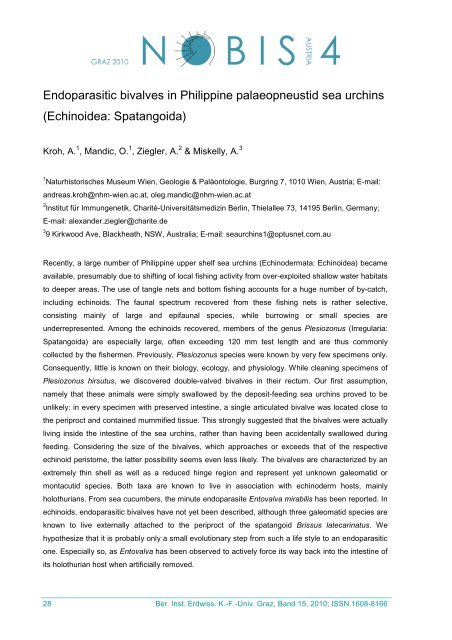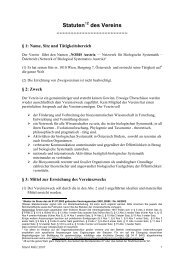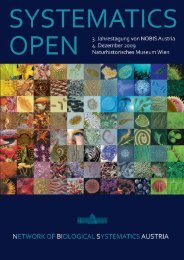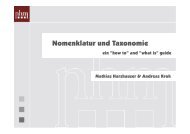4. Jahrestagung von NOBIS Austria 2. - 3. Dezember 2010
4. Jahrestagung von NOBIS Austria 2. - 3. Dezember 2010
4. Jahrestagung von NOBIS Austria 2. - 3. Dezember 2010
Create successful ePaper yourself
Turn your PDF publications into a flip-book with our unique Google optimized e-Paper software.
Endoparasitic bivalves in Philippine palaeopneustid sea urchins<br />
(Echinoidea: Spatangoida)<br />
Kroh, A. 1 , Mandic, O. 1 , Ziegler, A. 2 & Miskelly, A. 3<br />
1 Naturhistorisches Museum Wien, Geologie & Paläontologie, Burgring 7, 1010 Wien, <strong>Austria</strong>; E-mail:<br />
andreas.kroh@nhm-wien.ac.at, oleg.mandic@nhm-wien.ac.at<br />
2 Institut für Immungenetik, Charité-Universitätsmedizin Berlin, Thielallee 73, 14195 Berlin, Germany;<br />
E-mail: alexander.ziegler@charite.de<br />
3 9 Kirkwood Ave, Blackheath, NSW, Australia; E-mail: seaurchins1@optusnet.com.au<br />
Recently, a large number of Philippine upper shelf sea urchins (Echinodermata: Echinoidea) became<br />
available, presumably due to shifting of local fishing activity from over-exploited shallow water habitats<br />
to deeper areas. The use of tangle nets and bottom fishing accounts for a huge number of by-catch,<br />
including echinoids. The faunal spectrum recovered from these fishing nets is rather selective,<br />
consisting mainly of large and epifaunal species, while burrowing or small species are<br />
underrepresented. Among the echinoids recovered, members of the genus Plesiozonus (Irregularia:<br />
Spatangoida) are especially large, often exceeding 120 mm test length and are thus commonly<br />
collected by the fishermen. Previously, Plesiozonus species were known by very few specimens only.<br />
Consequently, little is known on their biology, ecology, and physiology. While cleaning specimens of<br />
Plesiozonus hirsutus, we discovered double-valved bivalves in their rectum. Our first assumption,<br />
namely that these animals were simply swallowed by the deposit-feeding sea urchins proved to be<br />
unlikely: in every specimen with preserved intestine, a single articulated bivalve was located close to<br />
the periproct and contained mummified tissue. This strongly suggested that the bivalves were actually<br />
living inside the intestine of the sea urchins, rather than having been accidentally swallowed during<br />
feeding. Considering the size of the bivalves, which approaches or exceeds that of the respective<br />
echinoid peristome, the latter possibility seems even less likely. The bivalves are characterized by an<br />
extremely thin shell as well as a reduced hinge region and represent yet unknown galeomatid or<br />
montacutid species. Both taxa are known to live in association with echinoderm hosts, mainly<br />
holothurians. From sea cucumbers, the minute endoparasite Entovalva mirabilis has been reported. In<br />
echinoids, endoparasitic bivalves have not yet been described, although three galeomatid species are<br />
known to live externally attached to the periproct of the spatangoid Brissus latecarinatus. We<br />
hypothesize that it is probably only a small evolutionary step from such a life style to an endoparasitic<br />
one. Especially so, as Entovalva has been observed to actively force its way back into the intestine of<br />
its holothurian host when artificially removed.<br />
_____________________________________________________________________________<br />
28 Ber. Inst. Erdwiss. K.-F.-Univ. Graz, Band 15, <strong>2010</strong>; ISSN 1608-8166






